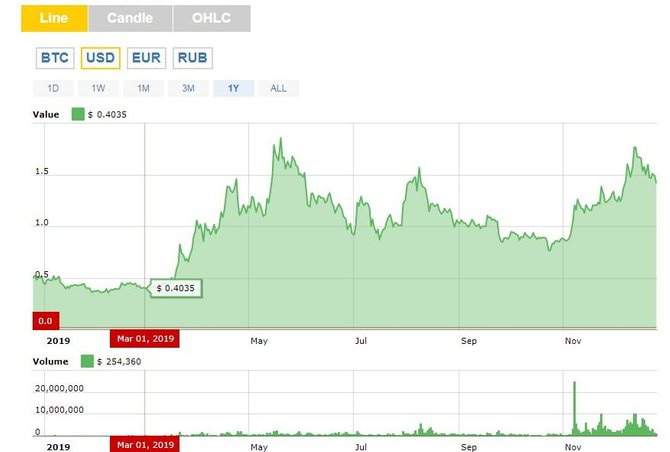
Staking can be called one of the most striking cryptocurrencies of 2019 - most cryptocurrencies are launched on PoS, and exchanges have begun to massively add the possibility of staking on their platforms. In light of this trend, Tezos distinguished itself, which can rightfully be called 2019 cryptocurrency staking.
Let's see what bonuses can bring staking to traders and holders and whether it can be better than the “go” strategy.
- Staking as a new way to make money on cryptocurrencies
- Is Staking a Deposit?
- Staking or Hodl?
- Staking growth in 2019: platforms and coins
Staking as a new way to make money on cryptocurrencies

Staking - freezing coins on a user's wallet to obtain voting rights and / or confirmation of new entries made to the blockchain. Staking is the basis of the PoS algorithm and an alternative way of cryptocurrency mining. Holding coins, users can make a profit without spending money on buying expensive ASIC miners and paying for electricity.
Advanced users and active members of the community freeze tokens in order to have the right to vote on making changes to the network. For investors and ordinary users, the reason is more prosaic - the reward for confirming transactions.
Is Staking a Deposit?

The last sentence causes a clear association of staking with a bank deposit. Regarding the systematic payment of interest, this is true, but there are a couple of significant differences:
- The deposit stipulates that you transfer money to the bank; when staking, the funds remain with you;
- The bank pays interest to the depositors for the right to use their funds, the blockchain pays interest for the holder of the currency participating in the confirmation of the transaction, i.e. for performing a specific function.
By the way, if we were talking about bank deposits, then staking in developed countries of Europe and the USA can be a good alternative to deposit, because banks in these regions switched to a zero or negative interest rate. Those. investing money in a deposit, the owner does not just not earn, and in some cases he will also pay the bank extra for the storage of funds.
Well, let's not forget that banks' interest rates are set centrally by financial regulators, and the deposit policy also depends on the management of the bank. In a PoS network, the size of the reward and other parameters of the blockchain can be changed by consensus of coin holders, that is, the latter have a voting right and not blindly obey the will of the regulator.
Staking or Hodl?

Many people also confuse staking with stall - they say all the same, keep coins and wait for profit. But this is not entirely true, or rather not at all:
- When staking, the owner of the coins receives a reward - a certain percentage of the amount of currency in the account, and receives it regularly. There was a wallet with 1000 ATOM, a month later they paid 5%, there is a wallet with 1050 ATOM. Profit? Profit;
- Hoddle is an investment strategy in which the owner does not make a profit for the direct holding of coins. The only profit he can count on is the income received as a result of the growth of the cryptocurrency rate in the future. That is, if he can sell his coins for more than he bought.
The real profit ultimately in both cases comes down to rate movements (if the same ATOM drops by 30%, then there will be little benefit from the 5% reward), but the staker gets double benefits - in the form of a reward for freezing coins and in the form of an opportunity to sell this coin in the future, counting on the growth of the rate.
In general, purely mathematically, staking is more profitable than common, but in addition to mathematics, there are also economic factors. In order not to get burned out at staking, you need to understand what prospects the cryptocurrency has, its liquidity, whether you can immediately withdraw your money and how valuable the project itself behind the held token is. Bitcoin owners, for example, will be able to immediately go into fiat, and you little-known steak token, even with huge percentages, can you immediately sell in case of a fall?
Staking growth in 2019: platforms and coins

In 2019, staking is gaining momentum, which is connected both with the increase in the number of currencies working on PoS (by the way, Ethereum will also switch to this model after the introduction of Casper hard fork) and with the search for new ways to make money on cryptocurrency. To assess the scale of growth in staking, let us recall a few facts:
- In March, Coinbase launched a staking service for institutional investors with support for the Tezos cryptocurrency, which provides 6% of the profit.
- In June, Poloniex unveiled Open Staking for Cosmos (ATOM), becoming the first Stake Exchange for all participants.
- In September, Binance joined them, and introduced 8 cryptocurrencies staking support at once, including NEO, Ontology and Vechain. Recently, it also became known that Binance will refuse the commission for Tezos staking.
- The last on this list were Kraken with support for Tezos staking and OKEx with DAI - they announced new services only in mid-December.
- Well, the Swiss from Bitcoin Suisse have already announced that they are preparing an infrastructure that will allow Ethereum 2.0 holders to earn money.
Tezos became the most popular cryptocurrency for staking in 2019. Compared to the March rate, its value has now grown more than 3 times from $ 0.4 to $ 1.4:

Well, and then the chain closed: they invested capital for the opportunity to receive interest, capital increased - value increased, more capital to get more profit from interest and again the price increase and all over again.
Tezos is now the most popular cryptocurrency for staking and growth of capitalization and support by leading cryptocurrency exchanges. It is interesting that its profitability of 6-7% per annum is not the highest on the market, but the prevalence and price increase more than compensate for this fact.
Let's not forget about the coins, which also occupy the leading positions in staking:
- Cosmos with an ATOM token, behind which is a network that ensures the compatibility of blockchains built on Tendermint technology. The profitability of this coin at Binnance is 6-9% per annum;
- DASH is one of the first cryptocurrencies with staking. It offers 6% annual interest, but the minimum number of frozen coins is 1000, which at a rate of $ 41 creates an almost unbearable threshold for private investors;
- Zcoin is another anonymous cryptocurrency. It is attractive for stakers because it offers a reward of 17% per year;
- NEO is a more conservative option that has already proven its viability in the market. It offers 2.3% per year and remuneration is paid not in NEO, but in GAS. A little, but reliable.
Remember, you can become a staker not only through the exchange, but also on your own. In fact, if you hold a coin in your wallet, then you are already a staker, however, to receive a reward you will need to constantly synchronize the wallet with the network (not always) and observe the minimum holding period.
If none of the above currencies suits you, then you can use Binance to search for alternative coins or, in the old fashion, google. Most likely, in 2020 the number of tokens and staking sites will only grow.


